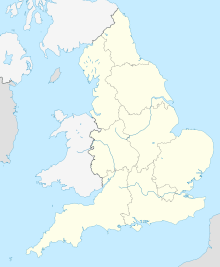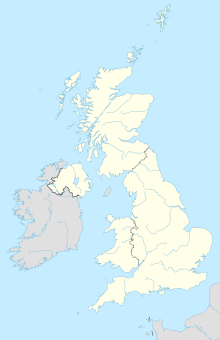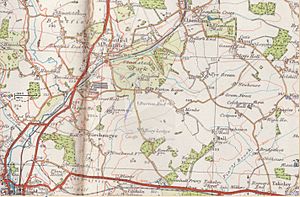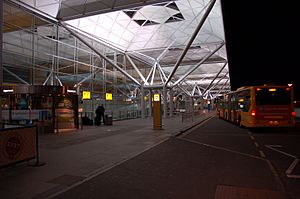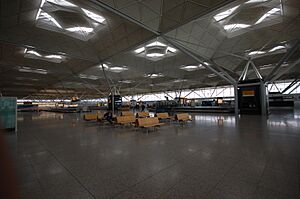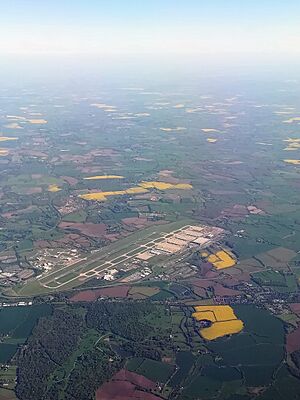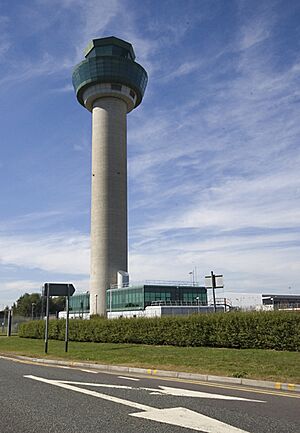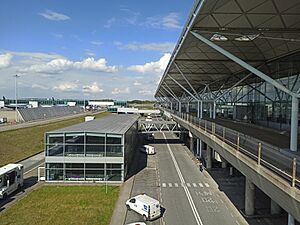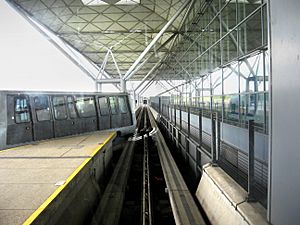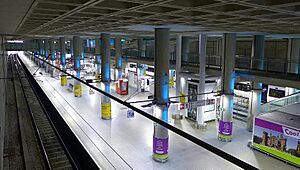London Stansted Airport facts for kids
Quick facts for kids
Stansted Airport
|
|||||||||||
|---|---|---|---|---|---|---|---|---|---|---|---|
 |
|||||||||||
 |
|||||||||||
| Summary | |||||||||||
| Airport type | Public | ||||||||||
| Owner/Operator | Manchester Airports Group | ||||||||||
| Serves | |||||||||||
| Location | Stansted Mountfitchet, Uttlesford, Essex, England, United Kingdom | ||||||||||
| Opened | 7 August 1943 | ||||||||||
| Elevation AMSL | 348 ft / 106 m | ||||||||||
| Coordinates | 51°53′06″N 0°14′06″E / 51.88500°N 0.23500°E | ||||||||||
| Map | |||||||||||
| Runway | |||||||||||
|
|||||||||||
| Statistics (2024) | |||||||||||
|
|||||||||||
Stansted Airport (IATA: STN, ICAO: EGSS) is a busy international airport that serves London, the capital of England and the United Kingdom. It is located near Stansted Mountfitchet, Uttlesford, Essex, about 42 miles (68 km) northeast of Central London.
Stansted is London's third-busiest airport. It offers flights to over 180 places in Europe, Asia, and North Africa. Many low-cost airlines use Stansted as a main base. For example, Ryanair has its largest base here, flying to more than 150 destinations. In 2022, Stansted was the fourth-busiest airport in the UK. Only Heathrow, Gatwick, and Manchester were busier.
During the COVID-19 pandemic in 2021, Stansted was the second-busiest airport in the country. The airport's runway is also used by private companies. These include Harrods Aviation, Titan Airways, and XJet terminals. They handle private flights, charter flights, and even visits from important government officials.
Stansted was originally a military airfield called RAF Stansted Mountfitchet. It was changed for civilian use in the late 1940s. The airport was managed by the British Airports Authority (BAA) starting in 1966. In February 2013, the BAA sold Stansted to Manchester Airports Group. This happened after a ruling by the Competition Commission in 2009.
The airport has one main passenger terminal, which opened in 1991. It has three separate buildings, called satellites, where the departure gates are located. The terminal building was designed by Foster and Partners. It is known for its important influence on airport design.
From 1997 to 2007, Stansted grew very quickly. This was because more people started flying with low-cost airlines. Passenger numbers reached a high of 24 million in 2007. After that, numbers went down for five years. But then they started to increase again. In 2016, 24.3 million passengers used the airport. Since then, the numbers have continued to rise.
Contents
Airport History
Second World War Use
The airfield opened in July 1943. It was built by the United States Army and some British Royal Engineers. During the Second World War, it was known as RAF Stansted Mountfitchet. It was used by the Royal Air Force and the United States Army Air Forces. It served as a base for bomber planes and a major repair center. Even though its official name was Stansted Mountfitchet, people usually just called it Stansted.
The base was first given to the USAAF Eighth Air Force in August 1942. It was a base for heavy bombers. Stansted was also a maintenance and supply depot. Here, they would fix and change B-26 planes. After D-Day, these activities moved to France. But the base was still used to store supplies for planes on the continent.
After the War
After the American forces left in August 1945, the Air Ministry took over Stansted. It was used to store things. From March 1946 to August 1947, it also housed German prisoners of war.
In November 1946, a new British cargo airline called London Aero and Motor Services moved to Stansted. They used old RAF Handley Page Halifax planes. They operated from Stansted until the company closed in July 1948.
The Ministry of Civil Aviation took control of Stansted in 1949. The airport then became a base for several UK charter airlines. The US military returned in 1954 to make the runway longer. This was in case it would be used by NATO. However, this never happened, and the airport continued to be used for civilian flights. It came under BAA control in 1966.
During the 1960s, 70s, and early 80s, a Fire Service Training School was located at the airport. This school trained all aviation fire crews for British airfields. It also trained crews from many other countries.
Under BAA Ownership (1966–2013)
From 1966, when BAA took over, Stansted was used by holiday charter airlines. These airlines wanted to avoid the higher costs at Heathrow and Gatwick airports.
Stansted had been considered as a possible third London airport since the 1950s. After a public review in 1966–67, the government set up the Roskill Commission. This group was to look again at the need for a third airport. The Roskill Commission did not choose Stansted as one of its top four sites. It suggested that Cublington should be developed. However, the government later decided to develop a site called Maplin in the Thames Estuary. But in 1974, the new government canceled the Maplin project due to economic problems.
Stansted was then considered again for future development. In December 1979, the government chose Stansted from a list of six options. The plan was to build a new terminal next to the existing runway. It also included protecting land for a second runway. This proposal was discussed in public inquiries from 1981–83. In 1985, the government approved a plan to develop Stansted in two stages. This would improve the airfield and terminal to handle 15 million passengers per year. However, the plan for a second runway was rejected.
Becoming London's Third Airport
The project to make Stansted London's third airport began in 1985. This was when the airport received permission to build a new terminal. This terminal was designed to handle up to 15 million passengers each year.
The project was planned in two stages. The first stage aimed for a capacity of 8 million passengers per year. The second stage would increase the terminal's capacity to 15 million passengers annually. It was thought that any future growth beyond this would need a second large terminal building.
The Foster Associates Terminal
Foster Associates, led by architect Norman Foster, designed the new terminal building. Peter Rice was the main structural engineer. The plans were approved in 1985. Construction took place from 1988 to 1991 by the John Laing company. It cost £100 million. The terminal building first opened in 1991. It won the European Union Prize for Contemporary Architecture in 1990. As part of the project, a railway line was built to the airport. The Stansted Airport railway station was built inside the terminal at ground level.
The building became famous for its high-tech design. Foster + Partners' design for Stansted Airport changed how airports were built. The building has open areas that connect the landside (before security) and airside (after security). It moved important services underground. This created an open and flexible main hall that gets lots of natural light. The "floating" roof looks like a swan in flight. The base of each roof support is a "utility pillar." These pillars provide light, air conditioning, water, and power. The airport was designed to make it easy for passengers to move from the car park, through check-in and security, to their gates, all on one level. These ideas influenced airport designs around the world.
In 1999, permission was given for the second stage of the terminal expansion. This included making the terminal wider and adding a third satellite building.
More Developments
A big expansion of the terminal happened between 2007 and 2009. The terminal was made wider, adding almost 5,900 square meters of space. This provided room for more baggage carousels and a new area for immigration and passport control.
In November 2006, the local council rejected a plan to increase flights and remove limits on passenger numbers. The airport appealed this decision. A public inquiry took place from May to October 2007. The appeal was allowed in October 2008. A legal challenge by a group called Stop Stansted Expansion was rejected in March 2009.
The Competition Commission decided in March 2009 that BAA should sell Gatwick and Stansted Airports. This ruling was later confirmed in July 2011. BAA lost an appeal in July 2012. Because of this, BAA decided not to appeal further. They confirmed on August 20, 2012, that Stansted Airport would be sold.
Under MAG Ownership (2013–Present)
In January 2013, it was announced that MAG (Manchester Airports Group) would buy London Stansted Airport for £1.5 billion. The sale was completed on February 28, 2013.
On June 20, 2013, MAG announced an £80 million plan to redevelop the terminal. MAG invested £40 million, and other companies invested the rest. This redevelopment moved the security area and doubled the amount of seating. It also improved the information screens. The new Departure Lounge now has a food court, new shops, and an Escape Lounge.
In 2017, Antonov Airlines opened a UK office at Stansted. They handle cargo charter flights, often for very large items.
COVID-19 Pandemic and Recovery
The COVID-19 pandemic greatly affected London Stansted Airport. It caused a big drop in passenger numbers and created many challenges. In 2020, the airport served just over 7.5 million passengers. This was a huge decrease from about 28 million passengers each year before the pandemic. At the worst point, Stansted saw a 95% drop in passengers compared to 2019. However, cargo operations increased by 53%. This showed how the airport adapted to new needs. Airport officials said it was a crisis like no other. They compared passenger levels to those from the early 1990s.
As travel rules started to relax in July 2021, London Stansted Airport faced many problems. Passenger numbers increased quickly during the summer holidays. The airport had staff shortages and new rules for COVID-19 documents. This led to long queues and confusing scenes. There were not enough staff to manage the crowds well. By late 2022, the airport showed signs of getting back to normal. Passenger levels were almost 97% of what they were before the pandemic.
After this recovery, Stansted Airport announced a £1.1 billion expansion plan in 2023. This includes a £600 million extension of the terminal and other facilities. The goal is to increase its capacity to serve up to 43 million passengers per year. This expansion is expected to add 200 flights per day. It will also create over 5,000 jobs over the next five years.
Airport Buildings and Facilities
Terminal and Satellite Buildings
The main terminal has three parts: the check-in area at the front, departures at the south end, and international arrivals at the north end. There is a separate area for domestic arrivals (from the UK). No gates are in the main terminal building. Instead, they are in three separate satellite buildings. One is connected by air bridges. Another is connected by the Stansted Airport Transit System (a people mover). The third is connected by both. There are also four gates accessed by bus from below the main terminal. The airport has 52 gates, with 12 jetbridges that planes can connect to. Plans for a fourth satellite building, approved in 1999 and updated in 2005, have not been built. Instead, that area was developed for remote parking stands in 2018.
As of 2013, Satellite 1 (Gates 1-19) was updated to attract more long-haul airlines. Also, a dual jetbridge was added at Gate 12. This allows faster boarding and deboarding for large planes. An extra building, called the Advanced Passenger Vehicle (APV), was brought back into use in 2016. It is used for flights leaving during the busy morning hours (6:00 AM to 9:00 AM). The APV building is linked to the main terminal by a walkway. It acts as a bus terminal for international flights at remote stands. Before Satellite 3 was finished, this terminal (then gates 90–95) was used regularly by passengers.
| Satellite building | Gate numbers | Passenger access | Notes |
|---|---|---|---|
| Satellite 1 | 1–19 | Transit system | Used by most major airlines like British Airways, Emirates, Pegasus, TUI, and Jet2. Ryanair and EasyJet do not use this area. It is the furthest away but the first stop on the transit from the main terminal. The transit ride takes about four minutes. This terminal has 10 jetbridges at gates 1, 2, 3, 4, 6, 7, 12, 13, 16, and 19. For the other gates (5, 11, 14, 15, 17, and 18), passengers walk across the tarmac and board using stairs. |
| Satellite 2 | 29–39 | Transit system | Used by AJet, Play, Ryanair, and sometimes KLM's Transavia and EasyJet. It is on the upper level of Satellite 2, accessed via the second stop on the transit from the main terminal. Jetbridges are reached by stairs, lift, or escalator one floor down (same level as gates 81–88). The transit ride takes about seven minutes. As of October 2024, only four jetbridges (Gates 30/88, 32/87, 33, and 37) are in use. |
| 81–88 | Walkway from main terminal | Used by EasyJet, Ryanair, and sometimes other airlines for international and domestic flights. It also serves as an exit for UK arrivals. International arriving passengers and those from the Common Travel Area are taken to the international arrivals hall by bus. It is located below gates 29–39 and takes up half of the first floor. It is parallel to the jetbridges used by gates 29–39. It is about a ten-minute walk from the terminal. | |
| Satellite 3 | 40–59 | Walkway from main terminal | Used only by Ryanair. This building does not have jet bridges. It is about a 15-minute walk from the main terminal. Gates 40-50 are on Level 1 and require walking to the plane. Gates 51-59 are remote gates, also requiring walking. |
| APV | 90–93 | Walkway from main terminal | Used by Ryanair during busy times. It acts as a terminal for buses that take passengers to remote stands. The gates are located underneath the main terminal, next to the quiet zone. It is about a four-minute walk from the main passenger area. |
Passengers arriving from within the UK use a separate exit. This exit is at the opposite end of the terminal from the international arrivals hall. It is connected by a footbridge only from Satellite 2 gates 81–88. If a domestic flight arrives at a gate not in Satellite 2, passengers are taken to a Satellite 2 gate by a free bus.
Passengers arriving from the Common Travel Area (like Ireland) are taken by bus from their plane to a separate entrance. This entrance is at the northeast of the terminal. It leads to the main baggage claim area, bypassing Border Force checks but not customs.
Car Parks
Stansted offers different car parking options. These include long-stay, mid-stay, and short-stay car parks. There are also valet and meet-and-greet services. Two drop-off areas are available. The express drop-off is near the short-stay car park and charges a fee. A free drop-off area is in the mid-stay car park. The old free drop-off area directly outside the terminal closed after MAG took over in 2013.
Control Tower
Stansted's air traffic control tower was finished in 1996. It was the tallest in Britain when it was built. It is located on the south side of the airfield, next to the main terminal. It replaced the old control tower, which had poor views of the airfield after the current terminal opened in 1991.
Cargo Handling
There are several buildings and hangars for cargo around the airport. The main cargo center is near the control tower. It handles most cargo flights, including large planes like the McDonnell Douglas MD-11 and the Boeing 747. There are also a few hangars on the other side of the runway. The largest ones are at the southeast of the airfield. One of these is used by Ryanair.
Other Facilities
Titan Airways has its main office at the airport. Several airlines used to have their main offices at Stansted. These included AirUK (later KLM uk), Buzz, AB Airlines, Lloyd International Airways, and Go Fly.
Since 2004, Stansted has offered several hotels. These include Holiday Inn Express, Novotel, Premier Inn, and Radisson Blu. The Hampton by Hilton recently opened. The Radisson Blu and Hampton by Hilton are both within a two-minute walk of the terminal. Regular bus services connect the terminal to the car parks and hotels.
Future Plans
Runway Plans
Plans for a Second Runway
On March 11, 2008, BAA submitted a plan to expand the airport by 3 square miles (7.8 km²) and build a second runway and terminal. This was part of a recommendation from a 2003 government paper on air transport. If approved, Stansted could have handled more passengers than Heathrow at that time.
In May 2010, BAA withdrew its plans to build a second runway at Stansted. They also withdrew plans for a new runway at Heathrow.
The 2003 paper had expected a second runway to be ready by 2011. However, this date kept getting pushed back. BAA's 2008 plan expected it to open in 2015. In 2009, BAA changed the expected opening date to 2017.
Before the UK general election in May 2010, all three major political parties promised not to approve a second runway. After the election, the new government confirmed this. BAA then withdrew its application for permission. They had spent nearly £200 million preparing for the public inquiry and buying properties.
The public inquiry for BAA's second runway plan was supposed to start on April 15, 2009. But it was delayed to allow BAA and the government to consider the Competition Commission's ruling. This ruling said BAA must sell Stansted within two years. In August 2012, after losing a court case, BAA agreed to stop fighting the ruling and sell Stansted.
In February 2010, a government official stated that the inquiry could not start until after the general election. He also said the planning documents were almost two years old and needed updating. Eventually, BAA realized it was pointless to continue with its plan. They withdrew it on May 24, 2010.
Stop Stansted Expansion
The group Stop Stansted Expansion (SSE) was formed in 2002. They responded to the government's ideas for expanding UK airports. They especially opposed plans for a new runway at Stansted. In September 2012, the government set up the Airports Commission. This group looked at what was needed to keep the UK as a major aviation hub. The commission decided that an extra runway was needed for Southeast England. They suggested it should be at either Heathrow or Gatwick. After the 2015 election, the commission recommended expanding Heathrow, with some environmental rules.
Terminal Plans
Ongoing Terminal Extension
In July 2023, MAG announced a new plan for the existing terminal building. They proposed to rearrange and extend it by three sections. This will increase its size by one-third. This plan aims to create more passenger facilities. It is expected to cost £600 million. The extension will add 16,500 square meters to the terminal. It is designed to increase passenger capacity from 35 million to 43 million per year. On November 1, 2023, the government approved this expansion plan. The new terminal design will include a larger departure lounge. It will also have an enlarged security hall and new facilities. These include more shops, bars, and restaurants. The baggage claim area will also get new carousels and more capacity for handling bags. The redevelopment will also add new check-in desks and next-generation security scanners. Satellite 2 (gates 20-39) is also being updated. It will get new flooring, lighting, and seating in the gate areas. The gate areas are also being changed to look more like typical gate rooms in other airports. This aims to create more space for passengers before they board their planes.
As part of this project, the current passenger transit system will be removed. It will be replaced with new walkways that connect the terminal to the satellite buildings. Also, the immigration hall will be moved to a new area downstairs in the terminal. The plan also includes building a 14.3-megawatt solar farm at the airport.
Construction of the extension is planned to begin in 2025. It is expected to take two to three years to complete.
Proposed Satellite 4
Plans for Satellite 4 have not been built. This satellite was to be located northeast of Satellite 3. It received permission in 1999. This was part of a plan to increase the airport's capacity from 8 to 15 million passengers per year. A revised plan in 2005 included a walkway link for the proposed satellite. Construction was planned for 2013-2015. However, the plans did not go forward after BAA was sold. Construction never started. In 2018, the site of Satellite 4 was instead used for remote parking stands. The current expansion plans for 2024 do not include Satellite 4. Instead, they focus on other improvements to the airfield and terminal.
Formerly Proposed Arrivals Terminal
In December 2016, London Stansted Airport announced plans for a new £130 million arrivals terminal. This was meant to handle more passengers and ease pressure on the existing single terminal. At the time, Stansted's single terminal was the busiest of its kind in the UK.
The new arrivals terminal was to be built next to the existing terminal and the Radisson Blu Hotel. It would have a larger immigration and baggage claim area. This new building would allow the existing terminal to be used only for departures. This would create more space for check-in, security, and the international departures lounge. It would have made London Stansted the only airport in the UK with separate terminals for arrivals and departures.
Construction was supposed to start in 2018 and take three years. However, the arrivals terminal project was put on hold at the end of 2019. This was due to changing travel demand and economic uncertainties. In 2020, the local council refused permission for the expansion. But the Planning Inspectorate overturned this decision after a public inquiry in 2021. Despite the approval, further delays and changes in the airport's priorities led to the arrivals terminal being postponed.
In 2023, after reviewing different ideas for increasing terminal space, Stansted Airport decided to cancel the arrivals terminal project. Instead, they chose to focus on expanding the existing terminal building from 1991.
Formerly Proposed Artwork
When the terminal was first being developed, in 1988, Norman Foster and artist Brian Clarke suggested several artworks for the building. The main idea was to cover the east and west sides of the terminal with two long sections of stained glass. These would run along the entire 162-meter length of the building. However, due to technical and security reasons, this artwork was not created. In 1991, the British Airports Authority asked Clarke to create a smaller stained glass project for Stansted Airport instead. The artist designed two stained glass friezes and a 6-meter high tower of stained glass. These were for a central area in the terminal and matched Foster's design. By 1994, the tower was removed to "allow greater flow of traffic." Later, the friezes were also removed.
Airlines and Destinations
Passenger Flights
The following airlines offer regular flights to and from Stansted Airport:
| Airlines | Destinations |
|---|---|
| Air Algérie | Seasonal: Algiers |
| AJet | Ankara, Istanbul–Sabiha Gökçen |
| Arkia | Tel Aviv (begins 3 August 2025) |
| British Airways | Florence Seasonal: Amsterdam, Bergerac, Geneva, Ibiza, Nice, Split Seasonal charter: Calvi |
| Corendon Airlines | Seasonal: Antalya |
| easyJet | Amsterdam, Belfast–International, Edinburgh, Glasgow Seasonal: Geneva, Zurich |
| Emirates | Dubai–International |
| FlyOne | Chișinău |
| HiSky | Chișinău, Oradea |
| Jet2.com | Agadir, Alicante, Antalya, Faro, Fuerteventura, Funchal, Gran Canaria, La Palma (begins 26 October 2026), Lanzarote, Málaga, Malta, Marrakesh, Palma de Mallorca, Paphos, Rome–Fiumicino, Tenerife–South Seasonal: Athens, Bodrum, Burgas, Catania, Chambéry, Chania, Corfu, Dalaman, Dubrovnik, Geneva, Girona, Grenoble, Heraklion, Ibiza, Izmir, Jerez de la Frontera (begins 1 May 2026), Kalamata, Kefalonia, Kos, Kraków (begins 27 November 2025), Larnaca, Menorca, Mytilene, Naples, Olbia, Prague, Preveza/Lefkada, Pula, Reus, Reykjavík–Keflavík, Rhodes, Salzburg, Samos (begins 7 May 2026), Santorini, Skiathos, Split, Thessaloniki, Tivat, Verona, Vienna, Zakynthos |
| Pegasus Airlines | Ankara, Antalya, Istanbul–Sabiha Gökçen, Izmir Seasonal: Gaziantep, Kayseri |
| Play | Reykjavík–Keflavík (ends 31 October 2025) |
| Royal Air Maroc | Seasonal: Casablanca |
| Royal Jordanian | Amman–Queen Alia |
| Ryanair | Aarhus, Agadir, Alicante, Ancona, Athens, Barcelona, Bari, Basel/Mulhouse, Belfast–International, Bergamo, Berlin, Biarritz, Bodrum, Bologna, Bratislava, Bremen, Brindisi, Brno, Bucharest–Otopeni, Budapest, Bydgoszcz, Cagliari, Carcassonne, Castellón, Catania, Cluj-Napoca, Cologne/Bonn, Copenhagen, Cork, Dalaman, Dublin, Dubrovnik, Edinburgh, Eindhoven, Essaouira, Faro, Fez, Fuerteventura, Funchal, Gdańsk, Genoa, Girona, Gothenburg, Gran Canaria, Hahn, Hamburg, Helsinki, Karlsruhe/Baden-Baden, Katowice, Kaunas, Kerry, Klagenfurt, Knock, Košice, Kraków, Lamezia Terme, Lanzarote, Limoges, Linz, Lisbon, Łódź, Lourdes, Lübeck, Luxembourg, Madrid, Málaga, Malta, Marrakesh, Marseille, Memmingen, Milan–Malpensa, Münster/Osnabrück, Murcia, Nantes, Naples, Newquay, Nuremberg, Olsztyn-Mazury, Oslo, Ostrava, Palanga, Palermo, Palma de Mallorca, Paphos, Perugia, Pescara, Pisa, Plovdiv, Podgorica, Poitiers, Porto, Poznań, Prague, Rabat, Reggio Calabria, Riga, Rome–Ciampino, Rzeszów, Salzburg, Sandefjord, Santander, Santiago de Compostela, Sarajevo, Seville, Shannon, Sofia, Stockholm–Arlanda, Stockholm–Västerås, Szczecin, Tallinn, Tangier, Tenerife–South, Thessaloniki, Tirana, Toulouse, Trapani, Trieste, Turin, Valencia, Venice, Verona, Vienna, Vigo (ends 31 December 2025), Vilnius, Warsaw–Modlin, Wrocław, Zagreb, Zaragoza Seasonal: Alghero, Almería, Bergerac, Béziers, Brive, Chania, Clermont-Ferrand, Corfu, Grenoble, Ibiza, Kalamata, Kefalonia, Kos, La Rochelle, Menorca, Nice, Nimes, Olbia, Örebro, Osijek, Ouarzazate, Perpignan, Ponta Delgada, Poprad–Tatry, Preveza/Lefkada, Pula, Reus, Rijeka, Rimini, Rhodes, Rodez, Rovaniemi, Salerno, Santorini, Tours, Zadar, Zakynthos |
| SunExpress | Antalya, Gaziantep, Izmir Seasonal: Adana/Mersin, Dalaman, Kayseri |
| Transavia | Rotterdam/The Hague |
| TUI Airways | Gran Canaria Seasonal: Chambéry, Corfu, Dalaman, Enfidha, Heraklion, Ibiza, Innsbruck, Kefalonia, Kittilä, La Romana (begins 16 February 2027), Menorca, Palma de Mallorca, Paphos, Rhodes, Salzburg, Sharm El Sheikh, Tenerife–South, Turin, Verona, Zakynthos |
| Turkish Airlines | Istanbul (begins 18 March 2026) |
Cargo Flights
| Airlines | Destinations |
|---|---|
| Asiana Cargo | Almaty, Frankfurt, Seoul–Incheon |
| Cargolux | Luxembourg |
| China Southern Cargo | Guangzhou |
| Emirates SkyCargo | Brussels, Dubai–Al Maktoum |
| FedEx Express | Dublin, Frankfurt, Indianapolis, Memphis, Paris–Charles de Gaulle |
| Qatar Airways Cargo | Doha |
| Turkish Cargo | Istanbul |
| UPS Airlines | Cologne/Bonn, Hong Kong, Louisville, Newark, Philadelphia |
New Routes and Changes
Long-haul flights to the United States started in 1987. In the early 1990s, American Airlines flew from Stansted to Chicago–O'Hare. But this route was not profitable and stopped in 1993. Continental Airlines also had a short-lived service to Newark Liberty International Airport in 2001. This service stopped after the September 11 attacks.
Long-haul flights to the US returned in late 2005. Eos Airlines and MAXjet Airways started all-business class flights to New York–JFK. In 2006, MAXjet added flights to Washington–Dulles, Las Vegas, and Los Angeles. American Airlines began daily flights to Stansted from New York–JFK in October 2007. However, due to economic problems, all three services to the United States stopped. MAXjet Airways closed in December 2007, and Eos Airlines in April 2008. In July 2008, American Airlines also stopped its flights from Stansted.
Long-haul flights across the Atlantic briefly returned in June 2010. Sun Country Airlines offered seasonal weekly flights from Stansted to Minneapolis/St. Paul. These flights stopped in Gander, Newfoundland and Labrador to refuel. This was because the Boeing 737-800 plane could not fly nonstop from Stansted to Minneapolis. These flights operated from June 11 to August 15, 2010. In 2011, Sun Country flew to Gatwick instead of Stansted. They then stopped these flights due to the cost of carrying fuel on long-haul journeys.
Long-haul flights to Asia began in March 2009. Malaysian low-cost airline AirAsia X offered direct flights to Kuala Lumpur International Airport. However, this service moved to Gatwick Airport in October 2011. It was later stopped completely. Low-cost airline Primera Air launched nonstop flights from Stansted to Boston, Newark, Toronto-Pearson, and Washington–Dulles. But the airline closed in 2018, ending these routes. This left Stansted without transatlantic flights again. In 2018, Emirates started daily flights to its hub at Dubai-International. They use their Boeing 777-300ER aircraft for this route. This service has since increased to twice a day.
The COVID-19 pandemic had a negative impact on the aviation industry. Stansted Airport was also affected. Several airlines had planned to start flights in 2020 or had recently begun operations. These included Ural Airlines (to Moscow–Domodedovo), Scandinavian Airlines (to Copenhagen), Air India (to Amritsar and Mumbai), Air Senegal (to Dakar–Diass), and El Al (to Tel Aviv). However, these flights have not returned. Also, easyJet, a major airline at the airport, closed its base at Stansted in August 2020. This base had more than two dozen routes and had been there for over ten years.
Airport Statistics
Growth Over the Years
In 1988, over 1.1 million passengers used Stansted. This was the first time more than 1 million passengers had passed through the airport in a year. The number of passengers grew steadily each year. By 1997, it reached over 5 million. It quickly rose to almost 12 million in 2000.
In 2007, passenger numbers reached a high of nearly 24 million. But then they went down for five years. In 2012, the total was about 17.5 million. In 2013, passenger numbers increased by 2.2% to 17.8 million. In 2014, they rose by 11.7% to 19.9 million. In 2015, they increased by 12.8% to 22.5 million. And in 2016, they grew by 8.0% to a record total of 24.3 million. This made Stansted the fourth-busiest airport in the United Kingdom. Stansted is also a major airport for cargo. In 2016, it was the third-busiest in the UK for freight. It handled over 223,203 tonnes. However, freight numbers have dropped slightly since their peak in 2005.
Passenger numbers for the year ending September 2016 increased by 8.4% to over 24 million. This was the first time since 2007. In 2023, passenger numbers reached 28 million.
Traffic Figures
| Year | Number of passengers |
Percentage change |
Number of movements |
Freight (tonnes) |
|---|---|---|---|---|
| 2000 | 11,878,190 | – | 165,779 | 167,823 |
| 2001 | 13,665,333 | 169,583 | 165,660 | |
| 2002 | 16,054,522 | 170,544 | 184,449 | |
| 2003 | 18,722,112 | 186,475 | 198,565 | |
| 2004 | 20,910,842 | 192,245 | 225,772 | |
| 2005 | 21,998,673 | 193,511 | 237,045 | |
| 2006 | 23,687,013 | 206,693 | 224,312 | |
| 2007 | 23,779,697 | 208,462 | 203,747 | |
| 2008 | 22,360,364 | 193,282 | 197,738 | |
| 2009 | 19,957,077 | 167,817 | 182,810 | |
| 2010 | 18,573,592 | 155,140 | 202,238 | |
| 2011 | 18,052,843 | 148,317 | 202,593 | |
| 2012 | 17,472,699 | 143,511 | 214,160 | |
| 2013 | 17,852,393 | 146,324 | 211,952 | |
| 2014 | 19,941,593 | 157,117 | 204,725 | |
| 2015 | 22,519,178 | 168,629 | 207,996 | |
| 2016 | 24,320,071 | 180,430 | 223,203 | |
| 2017 | 25,902,618 | 189,919 | 236,892 | |
| 2018 | 27,996,116 | 201,614 | 226,128 | |
| 2019 | 28,139,051 | 199,925 | 224,139 | |
| 2020 | 7,536,869 | 86,107 | 254,573 | |
| 2021 | 7,145,802 | 93,316 | 263,631 | |
| 2022 | 23,289,652 | 159,502 | 243 153 | |
| 2023 | 27,951,291 | 179,135 | 251,864 | |
| 2024 | 29,694,000 | 201,031 | 294,355 | |
| Source: UK Civil Aviation Authority |
||||
Busiest Routes
| Rank | Airport | Total passengers |
Change 2023 / 24 |
|---|---|---|---|
| 1 | 955,026 | ||
| 2 | 881,699 | ||
| 3 | 559,450 | ||
| 4 | 519,637 | ||
| 5 | 508,085 | ||
| 6 | 499,308 | ||
| 7 | 497,259 | ||
| 8 | 486,346 | ||
| 9 | 473,621 | ||
| 10 | 443,346 | ||
| 11 | 442,430 | ||
| 12 | 436,300 | ||
| 13 | 436,224 | ||
| 14 | 433,847 | ||
| 15 | 411,852 | ||
| 16 | 403,732 | ||
| 17 | 373,948 | ||
| 18 | 371,295 | ||
| 19 | 360,908 | ||
| 20 | 355,319 |
Getting To and From the Airport
Airside Transit System
The Stansted Airport Transit System connects the main terminal to the satellite buildings. It is a 2-mile (3.2 km) free automated people mover service. It runs on concrete tracks. The system uses Adtranz C-100 and CX-100 vehicles to take passengers to their departure gates. Unlike the Gatwick Airport Shuttle Transit, the Stansted transit can only be accessed after passengers go through security. As part of the airport expansion plans, this transit system will be removed in spring 2026. It will be replaced with walkways.
Trains
Stansted Airport railway station is located inside the terminal building. It is directly below the main concourse.
Trains to London are on the Stansted Express service. They go to and from Liverpool Street in Central London. This service runs every 15 minutes. The journey usually takes between 45 and 53 minutes. Liverpool Street station connects to the London Underground and the Elizabeth line. This allows access to many places across London. The Stansted Express also stops at Tottenham Hale. Here, you can connect to the Underground's Victoria line for North London and the West End. Some Stansted Express trains also stop at Stansted Mountfitchet, Bishop's Stortford, or Harlow Town on their way to London Liverpool Street.
CrossCountry operates a train service every two hours from the airport. These trains go to Birmingham New Street. They stop at Cambridge, Peterborough, Stamford, and Leicester. Greater Anglia runs services to Norwich via Cambridge.
Buses and Coaches
Scheduled express bus or coach services to and from London are provided by National Express and Flibco. The bus station is next to the terminal building.
Airport Bus Express operates service A21 to and from Liverpool Street Station via Stratford. National Express runs almost 200 round trips a day. They have services like A6 to Paddington Station (about every 30 minutes, taking 100 minutes). This route stops at Golders Green, Finchley Road, St. John's Wood, Baker Street, and Marble Arch. Service A7 goes to Victoria Coach Station (about every 30 minutes, taking 115 minutes). This route stops at Bow, Mile End, Whitechapel, Southwark, and Waterloo. Service A8 goes to King's Cross Station (about every 30 minutes, taking 115 minutes). This route stops at Tottenham Hale, Shoreditch, and Liverpool Street. Service A9 goes nonstop to Stratford (up to three times an hour, taking 50 minutes).
National Express also offers direct coach services to the airport from Luton Airport and Heathrow. They also have services from Birmingham (11 per day), Oxford (eight per day), Norwich (ten per day), and Cambridge (11 per day).
Stansted is also the starting point for the Essex Airlink X30 coach service to Southend-on-Sea. This route goes via Chelmsford and London Southend Airport. The X20 coach service goes to Colchester via Braintree. The X10 coach service goes to Basildon via Chelmsford. All these services are operated hourly by First Essex.
Local bus services connect to nearby towns. These include the 510/509/508 (Harlow to Stansted via Stansted Mountfitchet, Parsonage Lane, and Takeley, respectively). Also, the 7/7a (Bishops Stortford to Stansted), 133 (Braintree), and 6 (Saffron Walden) are operated by Arriva.
Roads
Stansted is connected to northeast London and Cambridge by the M11 motorway. It is connected to Braintree, Colchester, and Harwich by the A120 road. The A120 is a dual-carriageway until Braintree. The distance to London by road is 37 miles (60 km).
As of October 1996, the airport had 2,500 short-stay parking spaces. These are within walking distance of the terminal. Also, as of the same month, the airport had over 8,000 long-stay spaces. These are located near the M11 motorway and A120 junction. A free bus service connects the long-stay spaces to the terminal. The airport also offers mid-stay parking, which is closer to the terminal than the long-stay spaces. Stansted Airport also provides valet parking and a meet-and-greet service. These are similar to valet parking but are aimed more at people traveling for fun. Both services are run from the short-stay car park.
Airport Incidents
Stansted is the UK government's chosen airport for any planes that are taken over and request to land in the UK. This is because its design allows a plane that has been taken over to be kept far away from terminal buildings or runways. This means the airport can keep operating while discussions happen, or even during a rescue mission. Because of this, Stansted has been involved in more incidents where planes were taken over than might be expected for an airport of its size.
- On April 30, 1956, a Scottish Airlines Avro 685 York C.1 plane went off the runway. This happened during a takeoff that was stopped. The plane ended up in a drain, and its landing gear collapsed. Two passengers died out of 54 people on board.
- On December 23, 1957, a Scottish Airlines Avro 685 York C.1 cargo plane crashed. It was on its third attempt to land at Stansted. It hit a tree about three-quarters of a mile short of the runway and caught fire. All four people on board died.
- On February 27, 1982, an Air Tanzania Boeing 737-2R8C landed at the airport. The plane had been taken over during a flight from Mwanza to Dar es Salaam. It was flown to the UK after stopping in Nairobi, Jeddah, and Athens. Two passengers were released in Athens. The people who took over the plane wanted to speak to a Tanzanian politician. This request was granted. After 26 hours on the ground, the people who took over the plane gave up, and the passengers were released.
- On March 30, 1998, an Emerald Airways Hawker Siddeley HS 748 carrying the Leeds United F.C. football team had an engine problem right after takeoff. The right engine exploded. There were 40 passengers on board, including 18 from the Leeds team. Only two passengers were injured.
- On December 22, 1999, Korean Air Cargo Flight 8509, a Boeing 747-200F, crashed shortly after taking off from the airfield. This was due to pilot error. Only the four crew members were on board, and all of them died. The plane crashed in Hatfield Forest near the village of Great Hallingbury.
- On February 6, 2000, an Ariana Afghan Airlines Boeing 727 with 156 people on board was taken over. It was flown to Stansted Airport after stopping in Tashkent, Kazakhstan, and Moscow. After a four-day standoff, the people on board were safely freed, and the incident ended peacefully. The people who took over the plane wanted to seek safety in the UK. Many passengers on the plane also applied for safety. The rest returned to Afghanistan.
- On May 24, 2013, Pakistan International Airlines Flight 709 from Lahore, Pakistan, was escorted by RAF Typhoon jets. It was redirected from Manchester Airport because of a threat on board.
- On September 21, 2013, SriLankan Airlines Flight UL503, heading to Heathrow, was escorted by RAF Typhoon jets to Stansted Airport. It was redirected.
Protest Incidents
- In 2008, 57 people were arrested after Plane Stupid, an environmental group, entered the airport area. They created a "stockade" on a taxiway. This caused 52 flights to be canceled.
- In March 2018, a group of activists delayed a flight that was meant to send people to Nigeria.
See also
 In Spanish: Aeropuerto de Londres-Stansted para niños
In Spanish: Aeropuerto de Londres-Stansted para niños
- List of airports in the United Kingdom and the British Crown Dependencies
- Airports of London
- List of Royal Air Force stations



